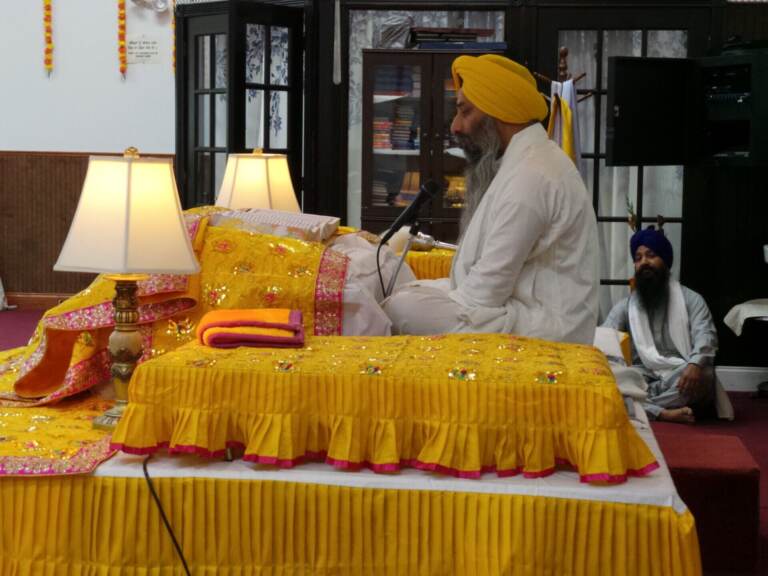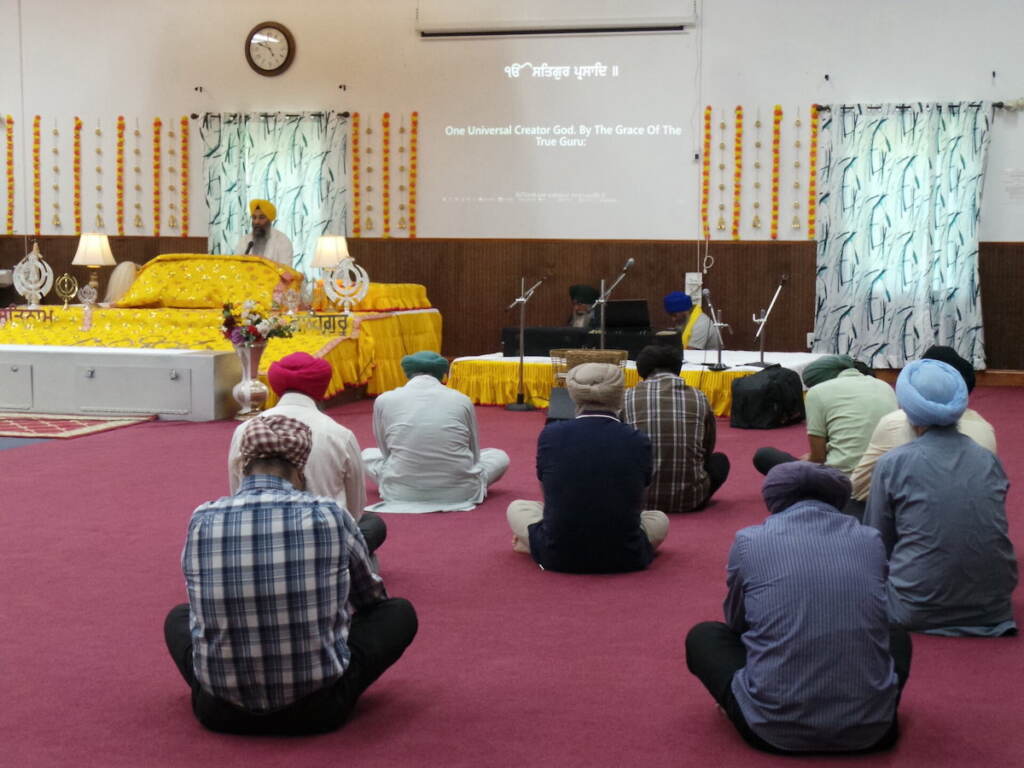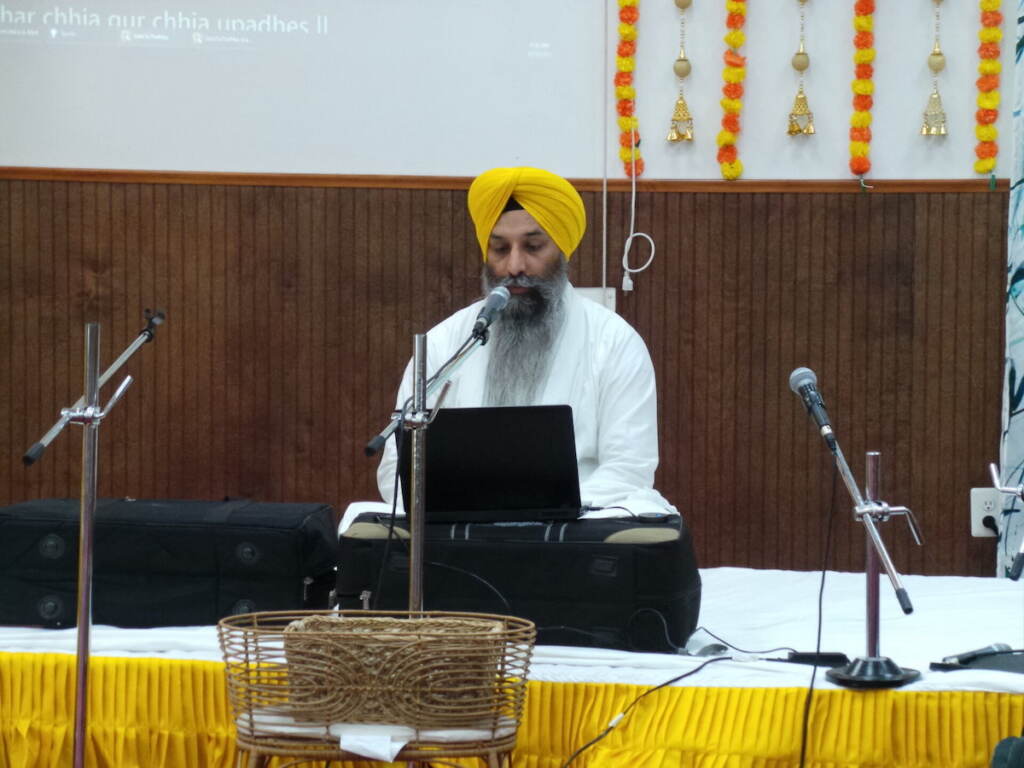New Jersey’s Sikh community want schools to teach kids about Sikhism
A N.J. resident drafted a resolution urging the state to incorporate instruction on Sikhism into grade-school curriculum. Community members say it could help prevent bullying.

Head Priest Giani Gurjit Singh recites hymns from the Sikh Holy Scripture as members of sangat (community) listen. (Courtesy of Jaspreet Singh, Community Development Director for Sikh Youth Alliance, Inc.)
After 9/11, Sikh Americans, who stand out in their vibrant turbans and unshorn beards and long hair, were wrongfully targeted for carrying out the terrorist attacks that killed about 3,000 people.
More than 20 years later, Sikhs living in New Jersey say their struggles continue.
They feel unseen and misunderstood. They want schoolchildren in New Jersey to learn about their faith and culture to change those misperceptions and encourage greater understanding and awareness.
“The community still feels that they are being alienated or they are being marginalized, and that’s why they feel that they are still invisible,” said Bhupindar Singh, a community organizer.

The Mount Laurel resident drafted a resolution urging the state to incorporate instruction on Sikhism into the grade school curriculum. The resolution, introduced in January by Burlington County Democrat Assemblywoman Carol Murphy, comes a year after Gov. Phil Murphy enacted a mandate requiring schools to include Asian American and Pacific Islander inclusive lessons in social studies classes.
The latest FBI report found that 11.6 % of religion-related hate crimes in 2021 were against the Sikh community. The same report found that Sikhs are among the most frequently targeted religious groups for hate crimes. Singh said that data is grossly underreported because the hate crime reporting system is antiquated. He added that because the reporting is voluntary many state and local agencies do not submit the information.
In June, the resolution drafted by Singh passed unanimously in the General Assembly and was filed with the secretary of state. But, resolutions are generally symbolic gestures that don’t require the state to act. Singh says there is more work needed to ensure Sikh-inclusive lessons are eventually implemented, including getting the Senate to also pass legislation.
Supporters argue the bipartisan effort could help prevent bullying and harassment against Sikhs in New Jersey.
“This legislation is vital to create a more diverse New Jersey, understanding a wide range of cultures is critical to extinguishing hate from our schools and communities,” Murphy said. “Our classrooms are a place to understand and discuss topics not seen in all communities, bringing together views from all corners of the state.”

History of Sikhs in the US
Sikhs began arriving on American shores in 1903, according to Harvard University’s Pluralism Project. The first U.S. gurdwara, the place of worship for Sikhs, opened in Stockton, California, in 1912. The American Sikh population grew substantially in the 1980s when many fled political persecution in India, according to the University of California Davis’ Pioneering Punjabis Digital Archive. There are about 500,000 Sikhs currently living in the USA, according to the Sikh Coalition. New Jersey is home to about 100,000 Sikh Americans, one of the largest concentrations of Sikhs living in the U.S.
Sikhism preaches the importance of community service and equality and respect for all humanity, no matter race, religion, creed, or gender, Bhupindar Singh said. It is a 500-year-old religion, which requires its followers to never shave or cut their hair. The men wear turbans as an outward display of their faith.
But because of the racist terrorist stereotype projected in the media, the beards and turbans are often what makes Sikhs vulnerable to targeted hate. There are 25 million people worldwide who identify as Sikhs, making it the fifth-largest religion.
New Jersey has a thriving Sikh community
At Gurdwara Khalsa Darbar, a small gurdwara in Burlington, people gather each Sunday morning to worship together and share a meal.
Gurgit Singh, a granthi, or head priest, at Khalsa Darbar, said the prayer services at the gurdwara help keep morale high despite discrimination the community faces. The worship leader also supports the resolution.
“We want to teach others good things about our religion and culture so that they learn and understand that we can build a cohesive and tolerant society,” Gurgit Singh, who speaks Punjabi, said through a translator.

The gurdwara is a haven for many Sikhs living in South Jersey, folks such as Manpreet Kaur who volunteer in the temple’s khalsa, or community kitchen. Every Sunday, Kaur and dozens of volunteers prepare traditional Indian dishes such as kheer, a rice pudding, and pakora, crispy fritters made from chickpea flour.
There are no chairs in the gurdwara. Instead, people sit on the floor during services and meals, to reinforce equality despite members’ socioeconomic status and gender.
“Serving the people fills my heart with a value of sympathy, empathy, and tolerance for other people,” Kaur said.

Kaur came to the U.S. as a teenager from Punjab, India. She says living in America comes with challenges and benefits. While bullying and workplace biases are common issues, Kaur said she appreciates her rights as a woman to participate in U.S. democracy.
“Discrimination does happen, but I feel America has given me a lot of opportunity, politically, socially, economically, and culturally,” she said.
Sikh political leaders speak up for their community
Members of the Sikh community have been active participants in the Garden State’s political and public spaces. In 2018, Bergen County’s Gurbir Grewal became the first Sikh U.S. attorney general in the nation’s history. That same year, his childhood friend and current Hoboken Mayor Ravinder Bhalla became the first Sikh mayor in New Jersey.
Bhalla wrote a letter to the state Legislature this year supporting the Sikh studies resolution.
“This is not complex. This is pretty simple,” Bhalla said. “The initiative is simply to educate the public, starting at the grade school level, about who Sikhs are, what our beliefs are, culturally, religiously, what our background is. And I think if kids are afforded the opportunity, kids are naturally curious. They have questions, we invite and embrace curiosity.”
Bhupindar Singh said there are a few schools that have already adopted Sikhism in their course offerings and he is hopeful that more will follow.
“We are looking forward to working with many township boards of education and we are urging them to include Sikhism instruction in their curriculum,” Singh said. “This should help the Sikh kids in school feel more seen and reduce the cases of bullying.”

Get daily updates from WHYY News!
WHYY is your source for fact-based, in-depth journalism and information. As a nonprofit organization, we rely on financial support from readers like you. Please give today.











